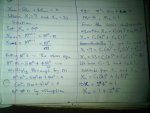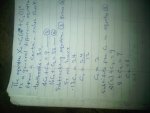So I had to solve the following problem...
Xn+1 - 5Xn + 4Xn-1 = 0 X1 = 9 and X2 = 33
So I set X = 1 and got:
X1+1 - 5X1 + 4X1-1 = 0
(33) - 5(9) + 4X0 = 0
33-45 + 4X0 = 0
-12 + 4X0 = 0
4X0 = 12
X0 = 3
So we know that X0= 3, X1=9, and X2=33
Knowing this, how do I write the equation?? The equation is Xn = 1 + 2 * 4n However, I have no idea how to arrive at that equation if the book did not tell me. Any help please? There are many problems like these, I can always solve for X but I can't find the general equation.
You can virtually "see" this one
if you already know the powers of 2: 3 is 1 greater than 2, 9 is 1 greater than 8, and 33 is one greater than 32, and 2, 8, and 32 are the successive odd powers of 2.
So
xn=1+2(2n−1)=1+2∗22n=1+2∗4n.
But perhaps you do not "see" that the powers of 2 are involved. What next?
If successive terms differ by a constant factor, you can discover the common factor as follows:
xn+1=a∗xn=0⟹xnxn+1=a.
That does not work here because 9 / 3 = 3 and 33 / 9 > 3.
If successive terms differ by a constant, you can find the constant as follows:
xn+1=xn+a⟹a=xn+1−xn.
That does not work here because 9 - 3 = 6 and 33 - 9 = 24. But maybe there is a ratio between these differences. 24 / 6 = 4.
We need more examples to see if there is a pattern.
x3−5x2+4x1=0⟹x3−5∗33+4∗9=0⟹x3=165−36=129.
x4−5x3+4x2=0⟹x3−5∗129+4∗33=0⟹x4=645−132=513.
So now the successive differences are 6, 24, 129 - 33 = 96, and 513 - 129 = 384.
But what are the ratios of the successive differences 24 / 6 = 4, 96 / 24 = 4, 384 / 96 = 4.
OK, it looks as though 4 is involved as follows:
xn−xn−1xn+1−xn=4⟹xn+1−xn=4xn−4xn−1⟹xn+1−5xn+4xn−1=0. We are definitely on the right track.
In fact, 24 / 6 = 4, 96 / 6 = 16, 384 / 6 = 64. It looks as though powers of 4 are involved.
x1=9=2∗4+1=1+2∗41.
x2=33=2∗16+1=1+2∗42.
x3=129=2∗64+1=1+2∗43.
x4=513=2∗256+1=1+2∗44.
This looks very promising. If this pattern works
1+2∗40=1+2∗1=1+2=3=x0.
Now lets test.
xn=1+2∗4n⟹xn+1−5xn+4xn−1=1+2∗4(n+1)−5(1+2∗4n)+4(1+2∗4n−1))=
1+2∗4(n+1)−5−10∗4n+4+8∗4(n−1)=
2∗4(n+1)−10∗4n+8∗4(n−1)=
2∗42∗4(n−1)−10∗41∗4(n−1)+8∗4(n−1)=
4(n−1)(2∗42−10∗41+8)=4(n−1)(2∗16−10∗4+8)=4(n−1)(32−40+8)=4(n−1)∗0=0.
I do not know a general method for finding a closed form for a recursively defined function. I generally work out a number of terms of the recursion and then start taking differences, ratios, ratios of differences until I find some consistent element and then start trying to use that consistent element as part of a pattern. If you take this experimental approach, you
must then test to make sure that the pattern is not spurious.


